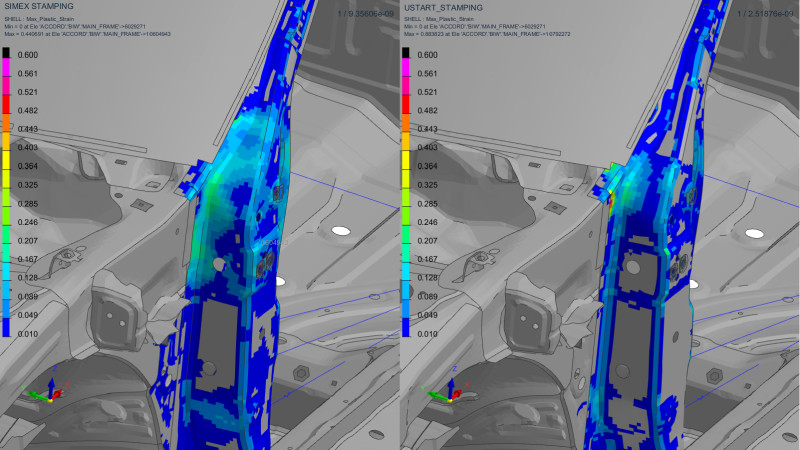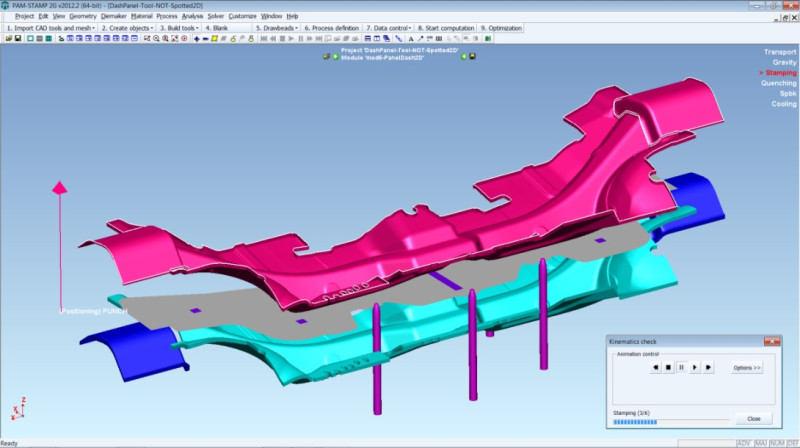Stamping out Defects: Using Sheet Metal Forming Simulation for Virtual Die Try-Outs
Enhancing Precision and Efficiency in Sheet Metal Forming

In today’s highly competitive manufacturing landscape, producing high-quality sheet metal parts efficiently and cost-effectively is more important than ever. Defects such as springback, wrinkles, and material thinning can severely impact the production process, leading to costly physical try-outs and delays. This is where virtual die try-outs come into play. By leveraging advanced sheet metal forming simulation software, manufacturers can predict and prevent defects early in the design phase, streamlining operations and ensuring that parts meet stringent quality standards from the outset. Let's explore how this innovative approach addresses some of the key challenges facing the sheet metal forming industry.
Challenges facing the Sheet Metal Forming Industry
The sheet metal forming industry faces several significant challenges that impact production efficiency and product quality:
Material Selection and Springback
Choosing the right materials is critical. Advanced High-strength steels (AHSS) and aluminum alloys are often used, although these materials can be challenging to form and often exhibit high springback magnitudes, which in turn makes achieving required dimensional accuracy a constant challenge.
Part & Process Design and Tooling
Part and process design can significantly affect the aesthetic quality of visible components, with defects emerging only during the first trials in the try-out stage of die manufacturing—when corrections are both time-consuming and costly and sometimes even cannot succeed for the full 100% in a given short timeframe, resulting in cars with (small) visible defects on the road.
During the stamping process, the continuous interaction between sheet metal and dies contributes to wear and tear, further impacting the final quality of stamped parts over the course of time. And as vehicle designs grow more intricate, the complexity and cost of designing and manufacturing stamping dies increase, as the dies must adapt to accommodate these evolving shapes and requirements.
Process Settings Optimization and Material Variation
Achieving optimal stamping conditions requires fine-tuning parameters like press speed, blank holder force, and lubrication, which can be a time-consuming process involving extensive testing.
Additionally, variations in material properties, even within the same batch, can impact the eventual part quality. These inconsistencies make it difficult to maintain tight tolerances and meet quality standards, leading to fluctuations in part quality.
Industry Transition
The industry must also continuously adapt to evolving environmental regulations, which necessitate the development of more sustainable and less energy-intensive processes. For example, can a press with less power be used to form the part? Can one operation be eliminated in a press line to reduce the number of presses needed?
Moreover, the rapid pace of innovation presents both an opportunity and a challenge for companies in finding a balance between investing in new machinery and training to stay competitive, while also managing the costs associated with these upgrades.
As a result, businesses are starting to turn to virtual solutions such as sheet metal forming simulation software to help overcome these real-world challenges.
Why would Organizations use Simulation to Solve these Challenges?
Simulation offers a powerful, cost-effective way to optimize processes, reduce errors, and enhance material efficiency. It digitally simulates the process of forming sheet metal, enabling the detection and resolution of potential issues before actual production begins. Simulation allows for the testing of different materials and designs without the need for expensive physical prototypes, enabling faster innovation and more precise control over the final product.
For example:
Material Complexity
For standard and complex materials, simulation can be applied to predict basic formability issues like cracks and wrinkles, but also in-depth analysis of part quality (thinning, stress, strain etc), minimal required press force, springback behavior and aesthetic quality.
Springback Control
Predicting the ‘elastic recovery’ of materials after the forming process, allowing for semi-/ automatic virtual adjustments of tooling and process parameters to achieve the desired final geometry of stamped components.
Cosmetic Defects
Final aesthetic part quality can be analyzed through standard contour settings like stress, strain and thinning, or specialized contours like digital stoning, or by placing the simulated part in a virtual lightroom to check the quality of the light reflections similar as done on the shopfloor.
Die Wear
Predict and optimize the contact pressures, material flow, and tooling conditions, allowing for the design and implementation of measures that reduce wear.
Additionally, simulation helps organizations meet environmental regulations by optimizing energy use and minimizing waste, all while maintaining high standards of quality and consistency. Through simulation, companies can also respond more effectively to supply chain fluctuations, as they can quickly adjust processes to accommodate changes in material availability or costs.
Sheet Metal Forming Simulation Software Applications in Industry
Sheet metal forming simulation software finds applications across various industries due to its ability to enhance productivity and reduce costs and decrease lead times. In the automotive and land transportation industries, it is a widely accepted solution and extensively used to validate the manufacturability and part quality of sheet metal formed components and optimize components like body panels, ensuring they meet safety, dimensional and aesthetic standards.
In the aerospace sector the software is crucial for simulating the many different manufacturing methods typical for this industry with low production volumes and often huge components, such as stretch bending, stretch forming, flex forming and rubber pad forming, amongst others. It also helps in creating complex geometries for aircraft fuselages and wing structures.
On the shop floor, these simulations facilitate almost real-time adjustments, enabling swift responses to production issues, leading to reduced downtime and enhances overall efficiency.

Understanding Sheet Metal Forming Simulation
Sheet metal forming simulation leverages advanced computational techniques, such as finite element analysis (FEA), to predict and analyze the behavior of metal sheets during the forming process. This simulation technology plays a crucial role in modeling the intricate details of material deformation under various conditions, taking into account factors like tool design, material properties, and process parameters.
One of the key advantages of using simulation in sheet metal forming is the ability to conduct virtual die tryouts. By simulating the forming process, manufacturers can identify potential issues such as wrinkles, splits, or excessive thinning before actual production begins. This proactive approach helps in optimizing material flow and ensuring that the metal forms correctly into the desired shape, which is particularly beneficial when dealing with new challenging materials or complex part geometries. For example, in the automotive industry, simulating the forming process of lightweight aluminum panels like doors or hoods, which can easily crack when some process or material parameters fluctuate slightly, can prevent costly production errors by upfront building robust process routes.
In addition to optimizing material flow, simulation also provides valuable insights into the surface quality of the final product, ensuring that the parts meet stringent quality standards.
Finite element methods are particularly crucial in analyzing the complex interactions between the metal blank and the die, ensuring that the final product meets the required specifications. Additionally, simulation software allows to optimize the initial flat blank contour to maximize material utilization, which is particularly beneficial for those focused on reducing material cost and waste and improving sustainability.
By leveraging these computational tools, manufacturers can achieve higher quality, more reliable sheet metal parts while minimizing costs and environmental impact.
Process Requirements for Effective Simulation
To ensure an effective sheet metal forming simulation, certain process requirements must be met. First, accurate material properties are essential. This involves understanding the mechanical properties of the material, such as yield strength, tensile strength, and maximum elongation.
Secondly, the software must incorporate a detailed finite element model. This model should be capable of accurately representing the geometry of the tooling and the sheet metal. It should also account for realistic contact interactions between the blank and the tools.
Furthermore, process parameters must be precisely calibrated. This includes defining forces applied, the speed of the press in case the used material is sensitive to strain rates, lubrication conditions, and temperature if applicable. These factors significantly influence the forming process and thus the final predictive confidence in the simulation output.
Another critical requirement is the definition of boundary conditions. These can include ambient room temperature, the direction of movement of tools, the constraints on the sheet metal, and the movement of the tooling. Correctly setting these parameters ensures realistic simulation results.
ESI's Sheet Metal Forming Solution

ESI’s sheet metal forming solution is a powerful tool designed to tackle the many challenges associated with modern manufacturing processes. At the core of its effectiveness is the accurate physics-based implementation, which captures real-world conditions for material behavior, contact forces, and process parameters. This allows manufacturers to predict springback—particularly in high-strength steels and aluminum—where it can be difficult to control due to large variations in magnitude. By simulating and compensating for springback early in the process, manufacturers save time and costs typically spent on physical try-outs, ensuring that the final shape meets specifications with fewer physical iteration loops.
A key feature is its precise formability prediction. The software’s solver can accurately predict forming defects in standard validation simulations, and even offers the possibility of an additional layer of security by assessing how small elastic deformations in the tools may affect the local contact force distribution and consequently the stress field in the part, which ultimately results in possible deviations from ‘standard’ springback predictions or might even negatively impact aesthetical appearance. This capability helps ensure that parts are formed correctly from the outset, minimizing defects and material waste.
Springback prediction and die compensation is another highlight. The solver’s integrated detailed physics representation in combination with its ability to continuously keep track of the local stress distribution throughout the forming process leads to superior springback results, from standard steel and aluminium up to the highest strength levels like DP800 and above. The solution has integrated functionality to automate tool compensation per operation and optionally can recreate CAD surfaces for the compensated tools, streamlining the entire workflow by facilitating the transition back to CAD environments like Catia and Unigraphics.
As a consequence of the accurate tool force prediction, ESI’s solution is also able to predict the minimum required press force to completely form the part. This enables production planners to select the right press lines with sufficient capacity with confidence. The highly efficient graphical environments dedicated to either automotive or aerospace processes, with each their own intuitive process workflows, and the seamless integration with high-performance computing (HPC) further enhances the speed and efficiency of large-scale simulations, making it an indispensable tool for sheet metal forming in today’s competitive manufacturing landscape.
For more information visit: Stamping & Forming Simulation Software
Katharine Edmonds is a Content Marketing Specialist at ESI Group, and has spent the past 9 years working in marketing and communications for SaaS providers in the engineering and manufacturing industries. Katharine leans on her knowledge and experience of CAD, PLM and eXtended Reality (XR) technologies to create engaging and informative content that champions the benefits of virtual prototyping, and bridges the gap between complex technical subjects and a broader audience.